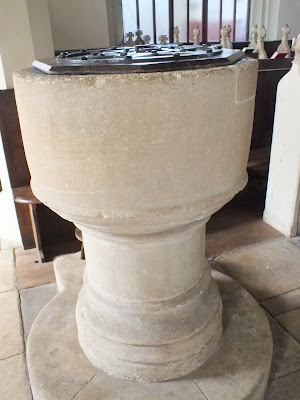Little darling, it's been a long cold winter
Little darling, it feels like years since it's been here
Here comes the sun, here comes the sun
And I say it's allright.
After a week of cold, drizzly days the sun finally emerged today and gave us the opportunity for what the Aussies might call a 'walkabout.'
We just wandered within 200 yards of our cottage and explored. What follows is a compilation of pictures from what we saw on today's outing.
This is the cottage directly across the path from our cottage. Love the thatched roof. Every roof here is either thatched or slate.
We wandered into an ancient church nearby. This reminded us of something found in Narnia.
The old church graveyard was amazing. The oldest stones date from about 200 years ago, but around the perimeter of the graveyard were stacked much older stones that were no longer legible. We were just reading a fascinating Bill Bryson book this week which talks about these old parish graveyards. Imagine that the church serves 2000 people roundabout the immediate area. (It IS the only church here!) And imagine that over the past 800 years the average lifespan has been 40 years- just a guess of course. That means that about 50 people have died and been buried here each year on average for eight centuries. That means about 40,000 folks have been buried in this graveyard. An English archaeologist suggests most of these old graveyards have risen three to four feet just due to the enormous amount of human remains interred here over the centuries. New bodies are buried atop older remains century after century. Strange.
Here's the local church itself: St. Andrew's Church of Kingham, Oxfordshire. This church is old by nearly any standards- originally built in 1253 and in in continuous use except for a period when the chancel became unusable between 1517-1531. It was rebuilt significantly in 1688 and has once again been in use since that time.
Some wildflowers growing in great profusion among the church lawn. These were perhaps 6" tall in all.
Here's the pipe organ. It's a very 'modern addition' only installed in 1882. Around here, 130 years is practically yesterday.
When we arrived we met an elderly couple perhaps age 90 or so. They were trimming the grass around the gravestones with shears and scissors but stopped to visit with us for a few minutes. The old man lamented the 'changing times' and said he had been baptized in the font below as an infant, but that they no longer use the font for baptisms- just a small bowl of water. I haven't a clue as to how old the font is but I wouldn't be surprised if it's 400 years or more.
This was leaning against the front wall of the sanctuary- perhaps left over from Easter services.
This is the largest of several stained glass windows in the chancel. I believe I understood that one rector in the 1600's tore out a larger window (presumably of Christ) and replaced it with this window of his wife and children after his wife's unexpected death at age 35. Rectors throughout England were ridiculously wealth, receiving enormous salaries often 100-150 times more than the average congregant. They were payed in rent tithes from every area farmer and landowner each year regardless of whether it was a good harvest or a bad one. Rectorships could be bought and handed down from father to son for 100's of years. Strangely, many had no training whatsoever in church matters but simply found it a lucrative career. Perhaps you remember that Elizabeth Bennet's friend Charlotte eagerly marries Mr. Collins, the local well-to-do rector under the thumb of Lady Catherine de Bourgh. To marry a rector at that time was an assurance of a very comfortable life indeed. Another very profitable practice was the annual renting of pews. If you wanted to come to church you had to rent your pew each year. In a time where locals might earn 40-60 pounds annually, rectors might earn 2000-6000 pounds. All of this to say the window was replaced at the whim of the rector who had the authority and the funds to make changes. Another local rector here paid to have the roof of the church replaced at a cost of 150 pounds from his personal funds when the townspeople agreed that was far too grand a sum for them them to raise themselves.
The ancient stone floor has been walked upon for more than eight centuries- since 300 years before the reformation!
Leaving the church we continued our walk toward a nearby pub for lunch. These photos are from the front yard and through the front windows of one admittedly whimsical cottage along our way.
Here's Jane's Evesham Asparagus with smoked pork belly, red mustard cress and paper-thin asparagus shoots with fresh pea tendrils..
Jane had a poached Lechlade trout with Hot smoked trout scotched egg, sampshire, Pickled cucumber and Mayan gold potatoes.
A hot cup of Earl Grey. The Brits KNOW how to serve tea properly- HOT!
Hot lemon souffle' with with warm lemon-thyme custard in the nearby pitcher.
Rhubarb & Brioche spring pudding with yoghurt & rhubarb sorbet.
Wildflowers grow in absolute profusion here. This is just an ancient stone wall next to the street with an abundance of various wildflowers growing out from between the rocks and hanging down everywhere.
Here's the local 'convenience store'. Jane loved the lace curtains in the upstairs windows. Think of a 7-11 set in 1770 and you'll pretty much have the picture.
Home to the cottage for a nap after a refreshing walk, an unexpected church tour and a delightful lunch. Lovely!






















3 comments:
It is thrilling my heart that this amazing trip is being experienced by the both of you. Thank you for sharing it.
sigh
That church is amazing!! How beautiful.
They are all wonderful photos, but the one that REALLY makes me want to hop on a plane and visit is the lemon souffle!
Post a Comment